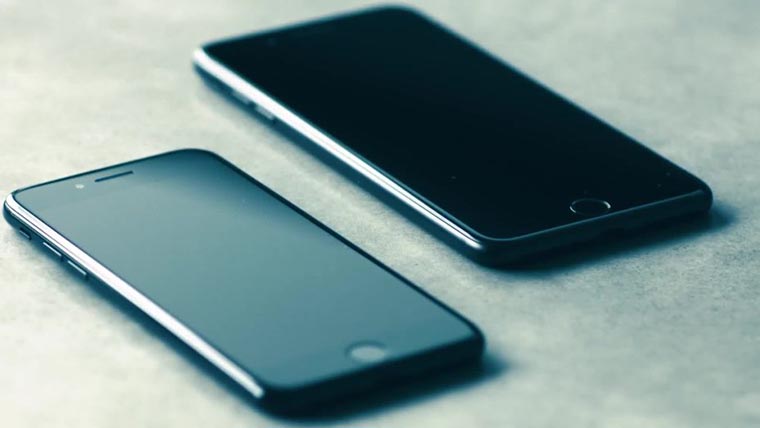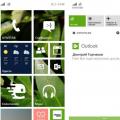Why does not the screen light up? How to overcome the black screen of death on iPhone
A fairly large number of phone users face a problem when during a call, the phone screen goes blank and nothing can be done. At this moment, the buttons, including the power button, do not work, the sensor does not respond to any actions, and the only way to return everything to normal is to pick up or hang up at the other end.
In most cases, this problem is related to the proximity sensor. But there can be a lot of problems with it.
I came across such problems, I did not read much about them until I had such a problem myself, twice. For the first time, this problem appeared with the Chinese Samsung copies S5. Second time with Xiaomi Mi4. No, it's not about Chinese phones, it just happened that way. When I was looking for information about why my screen goes blank during a call, I did not find such problems with Chinese replicas. As a rule, these were factory samsung, HTC, Nokia, and rarely Sony. I did not find any references to the screen that went out during a call on Chinese devices. And this confused me a lot, since many advised me to flash the device, and it is difficult to flash the Chinese device.
However, after navigating from phone user forums to tech forums, I concluded that the problem was not with the firmware, but with the proximity sensor. The proximity sensor is installed on any modern phone. Its main function, when obstacles are detected at a certain distance (your cheek is the obstacle), it turns off the screen to save energy, and also locks the buttons so that you do not accidentally press unnecessary buttons with your cheek or fingers during a call. After you have talked and removed the phone from your ear, the sensor detects that there are no obstacles and unlocks the phone for further use. This is if in simple words... And when there are any problems with the proximity sensor, the screen goes blank during the call, and you cannot do anything.
Typically, these problems happen for several reasons.
The first reason is the phones that have been repaired. Non-certified centers, and many private traders, forget to put an elastic band on the sensor, or put it on crookedly, as a result of which, in the first version, the sensor dangles freely and falls into the dead zones under the plastic; in the second case, the elastic overlaps the proximity sensor. In these cases, the best option is to take the phone back to the unfortunate master and make him do everything normally. You can try to disassemble it yourself, but I'm not a fan of disassembling devices where there are no bolts.
The second reason is the loose glass near the proximity sensor. As a result, the sensor "hits" the edge of the glass, and seeing the "obstacle" blocks the system. This situation can arise at any time, from buying a phone, during its operation, and ending with a fall or bump. This was exactly the problem in the Chinese replica. Samsung S5... They advised me to take it to the workshop, where they would solder the crane to the body for 1000 rubles. This is exactly what my friend did, it was with the real S5 (it turns out that this model has frequent problem), but warned that after that the phone would not be presentable, but the screen would stop dimming during a call. The basis of the method lies in the fact that the glass is pressed, the plastic is melted over it with a soldering iron, and the plastic, having melted, creeps onto the glass. As you understand, after that a "scar" will remain on the phone. This method did not suit me, and I decided to try another one, which cost me 76 rubles. I just bought Super Moment. I took the plastic from the Super Moment packaging, the plastic is needed in order not to absorb the glue. I put a drop of glue on the cardboard from the same package of glue. Thereafter. I touched this drop with the plastic. A small amount of glue remains on the plastic. after that, I, with this part of the plastic, ran along the protruding rear part of the glass and pressed it. A minute later he let go and checked the phone. The phone worked fine and the screen stopped dimming during a call. All this can be seen in the video at the end of the article.
Why did I do this particular algorithm? Just the laws of chemistry and physics, as well as the desire not to spoil appearance devices. If I took paper or cardboard, then the glue would be absorbed, and I would hardly apply anything. If I dripped on the place where the glass leaves the case, then the drop would seep under the glass, where it could splatter or glue the inner parts, and from above it would blur, albeit a small part of the glass. And this is a "blot" from which you cannot get rid of, respectively, the appearance is spoiled. Also, during pressing, all the excess glue would have to go somewhere, and this is only the inner part, or the upper part of the glass. In my version, the plastic from the packaging took exactly as much glue as I touched. Clay occupied the area that should have been occupied. After I began to lead, the end of the glass took only as much glue as the area of this glass could hold. By analogy with water, when you supply something under a tap from the tap, and the water begins to run over a given area (of course, if you have not turned on the pressure for the whole). Therefore, the glass took just as much glue as was enough for its area, and nothing more.
We will talk about the third version of the dying screen during a call in the next article, using the example of Xiaomi Mi4.
On your android, when you call, the screen immediately goes blank and turns black? If so, then the problem is most likely with the proximity sensor in the phone.
This problem can appear on any phone, for example, sony xperia, mi xiaomi, lumiya, compact, samsung, asus, xiaomi xiaomi, but it was noticed that most often the screen goes blank on sony z3.
Moreover, it happens that it goes out and does not turn on - this is no longer a joke. If this happens when answering a call or making an outgoing call, then most often the culprit is the proximity sensor.
What is a sensor and how does it work in android? The proximity sensor has several functions, but the most important task is to automatically dim and backlight the display during a voice call.
It does this by identifying what's next to your face and phone. When the phone comes close to your ear, the sensor detects your head and the screen turns off to avoid draining the battery and to prevent accidental disconnection of the conversation.
In turn, when you remove the phone from your ear, the screen lights up so that you can disconnect the call or use other functions ( numeric keypad, switch conversation to speaker, etc.).
When it comes to damaging the proximity sensor, the mechanism described above stops working, so the phone has no way of inferring whether it is currently near a face.
The problem with the proximity sensor usually manifests itself in the fact that the screen immediately goes out during a call and lights up only after a call, or vice versa - the screen does not go out, even if you put it to your face during a call.
Causes of problems with the proximity sensor when the screen goes blank during a call
The problem with the sensor can occur as in software, that and in purely mechanical damage.
If the problem is software related, you can often fix it yourself.
For example, by re-calibrating the sensor, restoring the phone to factory settings, or reinstalling software.
If the problem was the result, for example, of dropping the phone, then there was probably a mechanical damage to the sensor.
This often also happens when there is a "tearing off of the film" from the upper part of the case with the lower part of the phone (in particular, on the Sony Xperia).
Of course, clean mechanical problems the best solution is to send the equipment to service, because replacing the sensor is not easy.
Solution one when the phone screen goes out with an incoming call - remove the film or glass
First of all, remove the film or tempered glass from the phone screen. In some smartphones, due to their design, they can cover the sensor and cause erroneous detection distance.
Very often glass can also be the cause of problems with the proximity sensor - in stores you can find tons of very cheap, low-quality products that are not reliable.
Tearing off the tempered glass can restore the normal functioning of the sensor.
Of course, for some it may seem ridiculous, but uncle Google or Yandex will give you hundreds of records from their "warehouse", where users complain about problems with the proximity sensor after sticking Bad quality glass.
Solution two if the phone screen goes out when the call is answered - calibration
Sometimes the problem is a software update, for example, which for some reason contributes to the deregulation of the proximity sensor.
In this case, you can use free app, which, when installed in several stages, can calibrate the sensor, for example, Proximity Sensor Reset.
It is not difficult to use it - the wizard will guide you through the entire process, and at the end you must confirm the new calibration, which will restart the phone.
After that, you can make sure whether the calibration helped and now the phone screen does not go out during a call.
Solution three when the phone screen goes out on an outgoing call - restore factory settings
Another option that you can try is to factory reset your phone.
Unfortunately, this option deletes all data from your phone, so be sure to copy files, photos, music, videos, contacts, SMS and more to a safe place.
Then go to Settings> Backup and reset ”and select“ Factory settings ”.
Depending on the brand and installed version the software's factory settings can also be located elsewhere.
After confirmation, the phone will reboot and all data will be deleted, and the device settings will be reset to factory default.
When you turn on the phone for the first time, you need to re-enter the settings (select language, enter your google account etc.).
After completing the operation, make sure that the screen is working properly during a call and does not go out.
Solution four if the phone screen goes out - disabling the sensor
If your phone is no longer under warranty, and all other solutions have not helped, then the sensor is probably physically damaged, so the screen goes blank immediately after the call starts.
If you do not want to spend money on service, then turn off the screen off during a call.
As a result, the screen will be constantly lit during a call, and you will be able to use screen buttons to activate speakerphone or remove the keyboard.
The disadvantage of this solution is that when we are talking with a lighted screen, we can accidentally press the buttons.
In order to be able to disable the proximity sensor, you will need to install a special Xposed module Framework.
To do this, you need to get ROOT () to get administrative privileges,
Phone Screen Still Goes Off - A Few Proven Tips
Some owners were helped by the option of cleaning the speaker mesh. Sometimes there is a motion sensor. Take a small brush and clean everything neatly - suddenly it will help you too
Judging by the reviews, most often the screen turns off when making calls to sony phone z3 compact. Many managed to solve this problem in it by pressing on the upper right corner (there should be a sensor).
There are cases that on the Xperia Z3, when you press firmly on the top of the screen, even a click is heard inside and the problem disappears.
Some smartphones have a smart processing option in the call settings - try turning it off if you find it.
Sony phones very often peel off the screen from the case and such a problem arises - neat gluing solves it.
You can also disable the incall ui application in the application settings. If this does not help, then in the notification settings, try turning on notifications for this application.
Of course, other reasons are in no way excluded, but I will end there. As they say, what I could, so I helped. Good luck.
Spontaneous freezes and glitches of the iPhone, unfortunately, are no longer a rarity. Many are worried about this, and it seems that Apple is not going to do anything.
Our reader Alexander described the problem best of all:
This glitch really pisses off: a black screen appears on the iPhone 7 and 7 Plus. For example, when a call comes in, the screen simply does not light up (only vibration and the ringing sound), while responding only to the power button. You press the Home button at least a hundred times, the screen does not light up, and the vibration feedback clicks and that's it.
It happens periodically several times a day, I did not reveal any sequence leading to this. Honestly, I'm already tired, I don't have the strength to endure this outrage, I want to fire my iPhone against the wall, he infuriates, he is already ready to sell both.
Such a problem really exists, and the described case is far from the most difficult.
Why is this happening

"Black Screen of Death" is a relatively new concept for iPhone users, we rarely encountered such system failures before. Most often, this was solved by a banal reboot or firmware update.
Now almost every user of "apple" technology has seen similar failures on their device or on the device of friends. A black screen can appear on most models regardless of the iOS version.
There are several main reasons for this strange glitch:
1. Mechanical failure
Black screens often appear on devices that have been in the water. Even new iPhones 7 protected from moisture ingress are guilty of this. It is not at all necessary to flush the smartphone for this. It is enough to actively use it in a humid environment, in the rain or spray the device several times.
No service center will be able to establish 100% that a black screen began to appear on the device after it gets wet. However, the adoption of "water procedures" with a smartphone will be another reason to think about the reasons for such glitches.
2. Problematic software
Every year iOS becomes more open, developers can embed their modules into many standard programs. This can affect how iOS works.
Any system update can bring in a piece of code that does not fit well with existing applications or settings.
Only a complete cleaning of the device with firmware restoration can minimize the chance of a black screen, but not everyone can take such measures. Not everyone wants to turn their iPhone for 50 thousand into a test site.
3. Battery problems
Service technicians point out that battery problems can often cause a black screen to appear. An old, worn out battery can cause this.
On new gadgets, a black screen is often caused by an overheated battery. This can happen even on a fully functional device with a long connection to the charger.
What can be done

Unfortunately, there is no advice that helps in 100% of cases. We can offer such methods of "treatment".
1. To get started, make sure you are not running the beta version of iOS entirely from getting test builds.
2. Charge your smartphone. Do not charge your iPhone all night and stick to using gadgets in the winter.
3. Discard applications that are embedded in system programs. Now in App Store Lots of iMessage add-ons, Safari add-ons, Phone widgets, third-party keyboards and other add-ons. All of them are embedded in the system and can affect its operation.
4. Disable the function Raise to wake (Settings - Screen and brightness - Raise to activate), which is responsible for turning on the display when the user picks up the iPhone, or Opening with a finger (Settings - General - Accessibility - Home - Swipe to open).
It happens that it is the simultaneous operation of these two options that leads to system failures.
5. If all else fails, you can reset your iPhone to factory settings and use your smartphone, gradually adding apps from the App Store and making changes to settings.
Yes, the output is not the best, but this is the only way to establish exactly what exactly leads to the appearance of a black screen in a particular case.
We wish you not to get into such situations, and if you are, find the right way out faster. Happy holidays!
Apple Hot News:
Hello everyone! The problem voiced in the title of the article appears on phones Apple with an "enviable" frequency. The last time, in my memory, it was in 2014. And now, we are again stepping on the same rake. What is its essence? Yes, everything is very simple ...
During incoming call on the iPhone, the phone screen should light up and prompt you to answer the call. Yes, sometimes it is impossible to "pick up the phone" the first time and the display does not respond (), but it must show something!
However, after a recent firmware update, occasionally something strange happens. iPhone rings and vibrates, but its screen is black and there is no way to answer the call. On pressing Home buttons also no reaction. And this is terribly annoying - after all, no information is visible!
Moreover, at first glance, it is impossible to identify the pattern - it can take a week “normally” to receive calls, and then several times during the day “freeze” with a black screen with incoming calls.
The most important thing. With a high probability, this problem has nothing to do with "iron" and other mechanical damage. The same proximity sensor (the malfunction of which one would think) starts to work only after answering the call. And we cannot answer - our screen does not even light up. So the reason is most likely in the software or some external factors. And this is good.
And now, no less important is how to deal with all this. And let's start with what he advises technical support Apple. And she, judging by the messages on various resources, recommends:
- through, do not restore from backup and observe the behavior of the device. Basically, this is their standard recommendation.
- Visit authorized service center... The most interesting thing is that I managed to stumble upon a case when a person under warranty changed their phone because of a similar problem. I don't know if only the black screen during the call was the reason for the replacement or the ASC employees found some other defect, but the iPhone was replaced. But the most interesting thing is that everything repeated itself on the new device - this once again confirms our statement that the "breakdown" is exclusively in iOS.
- Wait for the engineers to fix the problem - they know about it, they are very sorry and will fix everything soon.
These are the three options for the development of events. By the way, hold on, you can contact them yourself - what if they advise something else sensible?
For those users who, for some reason, are not satisfied with the advice above, there are several more "popular" ways to deal with the absence of an image on iPhone screen with an incoming call:
As you can see, there are indeed a lot of options, but it is impossible to single out the only one acting among them. Judging by the messages from users, one thing helps everyone. Or maybe a combination of several actions.
Think everyone? But no. Finally, one more piece of advice that works great in my case. As we know, there are two different ways to end a call on an iPhone:
- Press the "off" button.
- Press "hang up" on the screen.
So, after I stopped breaking the connection using the mechanical key, and began to download the conversation exclusively by pressing the red button on the screen, all the problems disappeared.
Whether this is due to the fact that before that I performed many of the methods that I wrote about above - I do not know. But there is a fact - I still do not see a black screen with incoming calls.
Of course, we will hope that Apple will fix this annoying "glitch" in the software in the next firmware update. But if this does not happen, or if it repeats itself after some time, you know how to proceed :)
P.S. If you also encountered a similar problem, be sure to write in the comments. Or maybe there are only a few of us and I shouldn't be talking about Apple?
P.S.S. As I already wrote, it's a shame that you can't answer a call with buttons on the iPhone. It would be really very cool - "like" for such an option! :)
 Linkedin - what it is and how LinkedIn can help you find your dream job Linkedin professional network
Linkedin - what it is and how LinkedIn can help you find your dream job Linkedin professional network DDoS protection: DDoS GUARD - your secure hosting
DDoS protection: DDoS GUARD - your secure hosting Windows smartphones can now be updated using a PC
Windows smartphones can now be updated using a PC